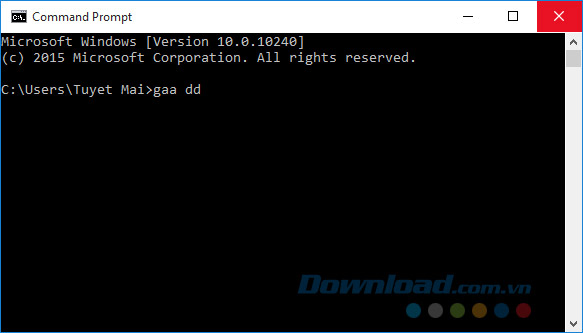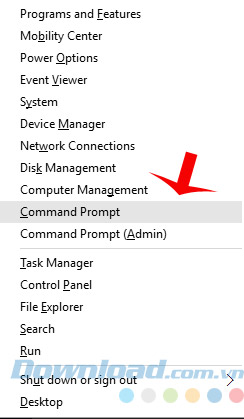Phím tắt thông dụng trong Command Prompt trên Windows 10
Command Prompt (CMD) giúp điều khiển hệ thống một cách dễ dàng thông qua dòng lệnh. Nếu bạn là chuyên gia máy tính hay lập trình viên chuyên nghiệp thì chắc chắn sẽ phải thường xuyên sử dụng công cụ này.
Vậy bạn đã biết hết những phím tắt sử dụng trên Command Prompt chưa? Nếu chưa hãy tham khảo bài viết dưới đây của Eballsviet.com để thao tác nhanh hơn:

Danh sách phím tắt hữu ích trên Command Prompt của Windows 10
Mở, đóng Command Prompt:
Có nhiều cách để mở hoặc đóng cửa sổ Command Prompt bằng phím tắt, tốt nhất bạn nên mở dưới quyền quản Admin để sử dụng được hầu hết các lệnh:
- Windows + X, nhấn phím C: Mở Command Prompt ở chế độ bình thường (Windows 10).
- Windows + X, nhấn phím A: Mở Command Prompt dưới quyền Admin (Windows 10).
- Windows (Windows + R), gõ CMD: Mở Command Prompt ở chế độ bình thường.
- Alt + F4 (hoặc gõ "Exit" tại dấu nhắc dòng lệnh): Đóng cửa sổ Command Prompt.
- Alt + Enter: Chuyển đổi từ chế độ toàn màn hình sang chế độ cửa sổ.

Phím tắt thao tác với văn bản:
- Ctrl + Backspace: Xóa từ ở bên trái điểm chèn.
- Tab: Tự động hoàn thành tên thư mục.
- Escape: Xóa dòng hiện tại của văn bản.
- Ctrl + C (Ctrl + Insert): Sao chép văn bản đang chọn.
- F2 + nhấn một chữ cái: Sao chép văn bản ở bên phải điểm chèn đến chữ cái mà bạn nhập.
- Ctrl + V (Shift + Insert): Dán văn bản từ Clipboard.
- Backspace: Xóa ký tự ở bên trái điểm chèn.
- Insert: Chuyển đổi chế độ chèn, cho phép gõ bất cứ gì để chèn vào vị trí hiện tại của dấu nhắc.
- Ctrl + Home/End: Xóa văn bản từ điểm chèn ở đầu hoặc cuối dòng hiện tại.
- Ctrl + Z: Đánh dấu kết thúc một dòng.
Phím tắt di chuyển:
- Home/End: Di chuyển dấu nhắc đến đầu/cuối dòng hiện tại.
- Ctrl + mũi tên trái/phải: Di chuyển dấu nhắc đến từ trước đó/kế tiếp trong dòng hiện tại.
- Ctrl + mũi tên lên/xuống: Cuộn trang lên hoặc xuống mà không di chuyển dấu nhắc.
- Ctrl + M: Truy cập hoặc thoát khỏi chế độ đánh dấu. Khi ở chế độ đánh dấu bạn có thể sử dụng 4 phím mũi tên lên, xuống, trái, phải để di chuyển con trỏ xung quanh cửa sổ.
Phím tắt chọn text:
- Shift + End: Mở rộng lựa chọn hiện tại đến cuối dòng.
- Ctrl + A: Chọn tất cả text trên dòng hiện tại. Nhấn thêm lần nữa để chọn tất cả text trên bộ đệm CMD (CMD Buffer).
- Shift + mũi tên trái/phải: Mở rộng lựa chọn hiện tại của một ký tự bên trái hoặc phải.
- Shift + Ctrl + mũi tên trái/phải: Mở rộng lựa chọn hiện tại của một từ bên trái hoặc phải.
- Shift + mũi tên lên/xuống: Mở rộng lựa chọn hiện tại của một dòng lên hoặc xuống.
- Shift + Home: Mở rộng lựa chọn hiện tại để bắt đầu một lệnh. Nhấn thêm lần nữa để bao gồm cả đường dẫn trong phần lựa chọn, ví dụ: C:\Windows\System32.
- Ctrl + Shift + Home/End: Mở rộng lựa chọn hiện tại về đầu hoặc cuối bộ đệm.
- Shift + Page Up/Page Down: Mở rộng lựa chọn hiện tại của một trang lên hoặc xuống.
Phím tắt với lịch sử Command:
- Alt + F7: Xóa lịch sử lệnh.
- F3: Lặp lại lệnh trước đó.
- Mũi tên lên/xuống: Di chuyển trở lại và kế tiếp các lệnh đã từng sử dụng.
- Mũi tên bên phải (F1): Tái hiện các ký tự lệnh trước đó bằng ký tự.
- F7: Hiển thị lịch sử các lệnh trước đó. Ngoài ra bạn có thể sử dụng phím mũi tên lên/xuống để lựa chọn bất kỳ một lệnh nào đó, sau đó nhấn Enter để thực hiện lệnh.
- F8: Di chuyển quay trở lại lịch sử lệnh để ghép với các lệnh hiện tại.
- Ctrl + C: Hủy bỏ dòng hiện tại đang nhập hoặc lệnh đang thực hiện.
Phím tắt bổ sung:
- Ctrl + F: Mở hộp thoại Find (Tìm kiếm).
- Alt + F4: Đóng cửa sổ CMD.
Lệnh trong hộp thoại Run:
Sử dụng các lệnh sau đây để truy cập vào vị trí các mục Control Panel, File Explorer một cách nhanh chóng thông qua lệnh Run. Đầu tiên, bạn nhấn Windows + R, rồi gõ:
- documents: Mở thư mục Documents.
- videos: Mở thư mục Videos.
- downloads: Mở thư mục Downloads.
- favorites: Mở thư mục Favorites.
- recent: Mở thư mục thường xuyên sử dụng.
- pictures: Mở thư mục Pictures.
- devicepairingwizard: Thêm thiết bị mới.
- winver: Mở hộp thoại About Windows.
- hdwwiz: Mở mục Add Hardware Wizard.
- netplwiz: Mở Advanced User Accounts.
- azman.msc: Mở Advanced User Accounts.
- sdclt: Mở Backup and Restore.
- fsquirt: Mở Bluetooth File Transfer.
- calc: Mở Calculator.
- certmgr.msc: Mở Certificates.
- systempropertiesperformance: Mở Change Computer Performance Settings.
- systempropertiesdataexecutionprevention: Mở Change Data Execution Prevention Settings.
- printui: Mở Change Data Execution Prevention Settings.
- charmap: Mở Character Map.
- cttune: Mở ClearType Tuner.
- colorcpl: Mở Color Management.
- cmd: Mở Command Prompt.
- comexp.msc: Mở Component Services.
- dcomcnfg: Mở Component Services.
- compmgmt.msc: Mở Computer Management.
- compmgmtlauncher: Mở Computer Management.
- displayswitch: Mở kết nối tới Projector
- control: Mở Control Panel.
- shrpubw: Mở Create A Shared Folder Wizard.
- recdisc: Mở Create a System Repair Disc.
- systempropertiesdataexecutionprevention: Mở Data Execution Prevention.
- timedate.cpl: Mở Date and Time.
- locationnotifications: Mở Default Location.
- devmgmt.msc: Mở Device Manager.
- hdwwiz.cpl: Mở Device Manager.
- devicepairingwizard: Mở Device Pairing Wizard.
- msdt: Mở Diagnostics Troubleshooting Wizard.
- tabcal: Mở Digitizer Calibration Tool.
- dxdiag: Mở DirectX Diagnostic Tool.
- cleanmgr: Mở Disk Cleanup.
- dfrgui: Mở Disk Defragmenter.
- diskmgmt.msc: Mở Disk Management.
- dpiscaling: Mở Display.
- dccw: Mở Display Color Calibration.
- displayswitch: Mở Display Switch.
- dpapimig: Mở DPAPI Key Migration Wizard.
- verifier: Mở Driver Verifier Manager.
- utilman: Mở Ease of Access Center.
- rekeywiz: Mở Encrypting File System.
- eventvwr.msc: Mở Event Viewer.
- fxscover: Mở Fax Cover Page Editor.
- sigverif: Mở File Signature Verification.
- fontview: Mở Font Viewer.
- joy.cpl: Mở Game Controllers.
- iexpress: Mở IExpress Wizard.
- iexplore: Mở Internet Explorer.
- inetcpl.cpl: Mở Internet Options.
- iscsicpl: Mở iSCSI Initiator Configuration Tool.
- lpksetup: Mở Language Pack Installer.
- gpedit.msc: Mở Local Group Policy Editor.
- secpol.msc: Mở Local Security Policy.
- lusrmgr.msc: Mở Local Users and Groups.
- locationnotifications: Mở Location Activity.
- magnify: Mở Magnifier.
- mrt: Mở Malicious Software Removal Tool.
- rekeywiz: Mở Manage Your File Encryption Certificates.
- mmc: Mở Microsoft Management Console.
- msdt: Mở Microsoft Support Diagnostic Tool.
- main.cpl: Mở Mouse.
- napclcfg.msc: Mở NAP Client Configuration.
- narrator: Mở Narrator.
- ncpa.cpl: Mở Network Connections.
- wiaacmgr: Mở New Scan Wizard.
- notepad: Mở Notepad.
- odbcad32: Mở ODBC Data Source Administrator.
- odbcconf: Mở ODBC Driver Configuration.
- osk: Mở On-Screen Keyboard.
- mspaint: Mở Paint.
- tabletpc.cpl: Mở Pen and Touch.
- collab.cpl: Mở People Near Me.
- perfmon.msc: Mở Performance Monitor.
- systempropertiesperformance: Mở Performance Options.
- telephon.cpl: Mở Phone and Modem.
- dialer: Mở Phone Dialer.
- powercfg.cpl: Mở Power Options.
- presentationsettings: Mở Presentation Settings.
- printmanagement.msc: Mở Print Management.
- printbrmui: Mở Printer Migration.
- printui: Mở Printer User Interface.
- eudcedit: Mở Private Character Editor.
- psr: Mở Problem Steps Recorder.
- appwiz.cpl: Mở Programs and Features.
- dpapimig: Mở Protected Content Migration.
- intl.cpl: Mở Region and Language.
- regedit: Mở Registry Editor.
- regedt32: Mở Registry Editor 32.
- rasphone: Mở Remote Access Phonebook.
- mstsc: Mở Remote Desktop Connection.
- resmon: Mở Resource Monitor.
- rsop.msc: Mở Resultant Set of Policy.
- syskey: Mở SAM Lock Tool.
- desk.cpl: Mở Screen Resolution.
- syskey: Mở Securing the Windows Account Database.
- services.msc: Mở Services.
- computerdefaults: Mở Set Program Access and Computer Defaults.
- shrpubw: Mở Share Creation Wizard.
- fsmgmt.msc: Mở Shared Folders.
- logoff: Mở Signout.
- snippingtool: Mở Snipping Tool.
- mmsys.cpl: Mở Sound.
- soundrecorder: Mở Sound recorder.
- cliconfg: Mở SQL Server Client Network Utility.
- stikynot: Mở Sticky Notes.
- credwiz: Mở Stored User Names and Passwords.
- mobsync: Mở Sync Center.
- msconfig: Mở System Configuration.
- sysedit: Mở System Configuration Editor.
- msinfo32: Mở System Information.
- sysdm.cpl: Mở System Properties.
- systempropertiesadvanced: Mở System Properties (Thẻ Advanced).
- systempropertiescomputername: Mở System Properties (Thẻ Computer Name).
- systempropertieshardware: Mở System Properties (Thẻ Hardware).
- systempropertiesremote: Mở System Properties (Thẻ Remote).
- systempropertiesprotection: Mở System Properties (Thẻ System Protection).
- rstrui: Mở System Restore.
- taskmgr: Mở Task Manager.
- taskschd.msc: Mở Task Scheduler.
- tpm.msc: Mở Trusted Platform Module (TPM) Management.
- optionalfeatures: Mở Turn Windows features on or off.
- useraccountcontrolsettings: Mở User Account Control Settings.
- utilman: Mở Utility Manager.
- sndvol: Mở Volume Mixer.
- wscui.cpl: Mở Windows Action Center.
- slui: Mở Windows Activation Client.
- windowsanytimeupgraderesults: Mở Windows Anytime Upgrade Results.
- isoburn: Mở Windows Disc Image Burning Tool.
- explorer: Mở Windows Explorer.
- wfs: Mở Windows Fax and Scan.
- firewall.cpl: Mở Windows Firewall.
- wf.msc: Mở Windows Firewall with Advanced Security.
- journal: Mở Windows Journal.
- wmplayer: Mở Windows Media Player.
- mdsched: Mở Windows Memory Diagnostic Scheduler.
- mblctr: Mở Windows Mobility Center.
- wiaacmgr: Mở Windows Picture Acquisition Wizard.
- powershell: Mở Windows PowerShell.
- powershell_ise: Mở Windows PowerShell ISE.
- msra: Mở Windows Remote Assistance.
- recdisc: Mở Windows Repair Disc.
- wscript: Mở Windows Script Host.
- wuapp: Mở Windows Update.
- wusa: Mở Windows Update Standalone Installer.
- winver: Mở Versione Windows.
- wmimgmt.msc: Mở WMI Management.
- write: Mở WordPad.
- xpsrchvw: Mở XPS Viewer.
Hy vọng bài viết trên sẽ giúp các bạn thao tác trên Command Prompt nhanh chóng hơn. Ngoài ra, có thể tham khảo thêm Top những lệnh Run thông dụng, để dễ dàng điều khiển hệ thống.
Chúc các bạn thực hiện thành công!
Theo Nghị định 147/2024/ND-CP, bạn cần xác thực tài khoản trước khi sử dụng tính năng này. Chúng tôi sẽ gửi mã xác thực qua SMS hoặc Zalo tới số điện thoại mà bạn nhập dưới đây:





















